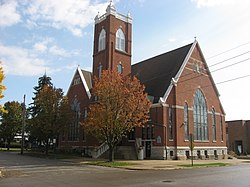
Chatham–Arch is a neighborhood located immediately east of Downtown Indianapolis, Indiana, United States. This neighborhood is one of the oldest in Indianapolis, dating back to the mid 19th century. Chatham–Arch contains many of Indianapolis's historic homes.

Allen Chapel African Methodist Episcopal Church is a church in Terre Haute, Indiana.

St. John's Episcopal Church is a historic Episcopal church located at Lafayette, Tippecanoe County, Indiana. Founded by Parson Samuel R. Johnson, early services were held beginning in 1836–37 in the counting room of Thomas Benbridge. Benbridge had an accounting office. The first building dedicated on 30 Dec 1838 on Missouri St. A new Gothic Revival style church was built in 1858 on the Northwest corner of Sixth and Ferry. Major repairs were completed in 1887 with the addition of a Sunday School.
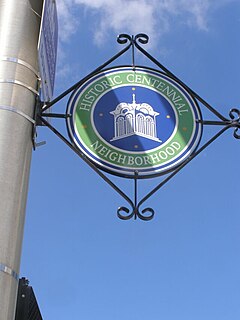
Centennial Neighborhood District is a national historic district located at Lafayette, Tippecanoe County, Indiana. The area originated as the Bartholomew and Davis Additions to Lafayette in 1829. Growth came rapidly after the Wabash and Erie Canal arrived in 1843. Growth continued with the arrival of the railroad in 1853. The Centennial Neighborhood Historic District takes its name from the Centennial School, which was constructed in 1876 on the centennial of the nation. The school was located on the north east corner of Brown Street at North 6th Street. The school has been removed and a park created at its original location.

The Cathedral of St. James is an Episcopal cathedral in South Bend, Indiana, United States. It is the seat of the Diocese of Northern Indiana. The cathedral church and the adjoining parish hall were placed on the National Register of Historic Places in 1985.

Old Plat Historic District is a national historic district located at Huntington, Huntington County, Indiana. The district includes 177 contributing buildings and 2 contributing structures in a mixed residential section of Huntington. It developed between about 1860 and 1920 and includes notable examples of Greek Revival, Gothic Revival, Italianate, and Queen Anne style architecture. Notable buildings include the Mathew Luber House, George W. Humbert House, Trinity Methodist Episcopal Church (1914), First Church of Christ Scientist, and Masonic Temple (1926).
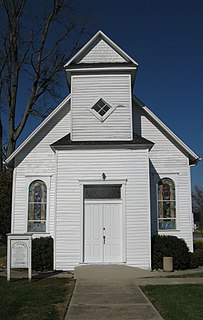
St. Stephen's African Methodist Episcopal Church is a historic African Methodist Episcopal church located at Hanover, Jefferson County, Indiana.

Franklin Street Commercial Historic District is a national historic district located at Michigan City, LaPorte County, Indiana. The district encompasses 73 contributing buildings and 1 contributing object in the central business district and surrounding residential section of Michigan City. It developed between about 1875 and 1955, and includes examples of Italianate, Gothic Revival, Queen Anne, Classical Revival, and Tudor Revival style architecture. Located in the district is the separately listed Michigan City Post Office (1909-1910). Other notable buildings include the Staiger House, Earl House, M & M Diner (1955), Zorn Building (1907), St. Paul's Lutheran Church (1876) and rectory (1888), First Federal Savings Bank, Aicher Block (1914), Brinkman Building, Trinity Episcopal Church (1889), Merchants National Bank Building (1926), Ledbetter Building (1908), Rodenbeck Saloon, First Methodist Episcopal Church (1922), Barker Hall (1929), Masonic Temple (1922-1923), and the Salvation Army Building (1925).

Mooresville Commercial Historic District is a national historic district located at Mooresville, Morgan County, Indiana. The district encompasses 35 contributing buildings and 1 contributing object in the central business district of Mooresville. It developed between about 1872 and 1952, and includes notable examples of Italianate, Gothic Revival, Classical Revival, Commercial Style, and Bungalow/American Craftsman style architecture. Notable buildings include the Farmer's State Bank, Nelson and Son Hardware, Mooresville Carnegie Library (1916), Carlisle and Gilbert Building (1895), Pure Oil Service Station, A.H. Scruggs Building, Mooresville Municipal Building, and Mooresville Methodist Episcopal Church complex.

Morgantown Historic District is a national historic district located at Morgantown, Morgan County, Indiana. The district encompasses 34 contributing buildings in the central business district and surrounding residential sections of Morgantown. It developed between about 1840 and 1956, and includes notable examples of Greek Revival, Italianate, Late Gothic Revival, Queen Anne, and Bungalow/American Craftsman style architecture. Notable buildings include the Farmer's Cooperative Store / Blanche Crawford Building, First National Bank (1905), Obenshain Hotel (1860), Morgantown Town Hall (1900), Griffitt-Murphy House and Livery Bank (1895), Parkhurst House (1865), Redman's Lodge (1908), Wisby Hotel (1918), Telephone Exchange (1906), and Morgantown Methodist Episcopal Church complex (1923).
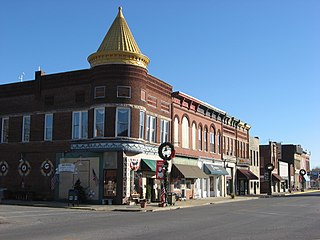
Orleans Historic District is a national historic district located at Orleans, Orange County, Indiana. The district encompasses 163 contributing buildings, 4 contributing sites, and 10 contributing objects in the central business district and surrounding residential sections of Orleans. It developed between about 1837 and 1958, and includes notable examples of Italianate, Queen Anne, Second Empire, Gothic Revival, Colonial Revival, Classical Revival, Tudor Revival, and Bungalow / American Craftsman style architecture. Notable buildings include the Cornelius-Osborn Building (1927), Magner-Lindsey Hotel, Roberts Building / Herle's Restaurant, Presbyterian Church, Methodist Episcopal Church (1915), Bowles Building (1889), Hollowell Brothers Building (1897-1898), Orleans Public Library (1915), and Ashland Service Station (1955).

Welborn Historic District is a national historic district located at Mount Vernon, Posey County, Indiana. The district encompasses 154 contributing buildings and 5 contributing structures in a predominantly residential section of Mount Vernon laid out by Jesse Welborn between 1822 and 1826. It developed between about 1840 and 1942, and includes notable examples of Greek Revival, Gothic Revival, Italianate, Romanesque Revival, and Colonial Revival style architecture. Notable contributing buildings include the Gov. Alvin P. Hovey House, Edward Sullivan House (1860), C.P. Klein House Johnson-Rosenbaum House (1905), St. Matthew's Catholic Church (1880), First Presbyterian Church (1872), Trinity Evangelical Church (1883), St. John's Episcopal Church (1892), Mount Vernon Post Office (1931).

Rushville Commercial Historic District is a national historic district located at Rushville, Rush County, Indiana. The district encompasses 54 contributing buildings in the central business district of Rushville. The district developed between about 1847 and 1940 and includes notable examples of Greek Revival, Italianate, Romanesque Revival, Classical Revival, Collegiate Gothic, Commercial style, and Art Deco style architecture. Located in the district are the separately listed Durbin Hotel, Melodeon Hall, and Rush County Courthouse. Other notable buildings include the former Methodist Episcopal Church (1847-1850), Church of Christ / Boys' and Girls' Club (1850-1853), Beher-King Block (1883), Presbyterian Church (1892-1893), Rushville National Bank (1911), Phoenix Lodge (1913–1915), Rushville Public Library, and former Castle Theatre (1939).

West Washington Historic District is a national historic district located at South Bend, St. Joseph County, Indiana. It encompasses 330 contributing buildings in an upper class residential section of South Bend. It developed between about 1854 and 1910, and includes notable examples of Italianate, Greek Revival, and Romanesque Revival style architecture. Located in the district are the separately listed Morey-Lampert House, Oliver Mansion designed by Lamb and Rich, Second St. Joseph County Courthouse, South Bend Remedy Company Building, and Tippecanoe Place. Other notable buildings include the Bartlett House (1850), Birdsell House (1897), DeRhodes House designed by Frank Lloyd Wright, Holley House, Kaiser-Schmidt House, Listenberger-Nemeth House, Meahger-Daughterty House (1884), O'Brien House, Oren House, The People's Church (1889), St. Hedwig's Church, St. Patrick's Church (1886), St. Paul's Memorial United Methodist Church (1901), West House, and a rwo of worker's house.

Stidham United Methodist Church is a historic Methodist church located at Shadeland, Tippecanoe County, Indiana. It was built in 1912–1913, and is a 1 1/2-story, co-axial plan Gothic Revival style brick building topped by a steeply sloped gable roof. It features a crenellated bell tower with masonry buttresses and an American Craftsman style plain wood portico.

Bethel Methodist Episcopal Church, also known as the Bethel Church, is a historic Methodist Episcopal church located at Harrison Township, Wells County, Indiana. It was built in 1900, and is a two-story, irregular plan, Romanesque Revival style brick building. It is topped by hipped and gable roof masses. It features a three-story bell tower at the main entrance.

Bethel A.M.E. Church is a historic African Methodist Episcopal church located at Richmond, Wayne County, Indiana. The congregation was founded in 1836. The church was built in 1854, and enlarged and remodeled in the Romanesque Revival style in 1892–1894. It is a one-story, cruciform plan, brick building with a 2 1/2-story bell tower. The church serves as an educational, political, and cultural center for the local African-American community.

Hopewell Methodist Episcopal Church and Cemetery is a historic Methodist Episcopal church and cemetery located in Lagro Township, Wabash County, Indiana. It was built in 1872, and is a one-room Gothic Revival style brick church. It has a front gable roof and features a bell tower and pointed arched windows. Also on the property is the contributing cemetery, which accepted its first burial in 1849, and the church's 19th century bell.
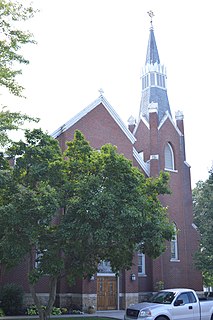
Delphi Methodist Episcopal Church is a historic Methodist Episcopal church complex located at Delphi, Carroll County, Indiana. The brick and limestone trimmed Gothic Revival style church sanctuary/auditorium was constructed in 1869 with alterations in 1884, 1897, and 1926. It features a massive three-story bell tower on its northeast corner. The education wing was constructed in 1926 in the Collegiate Gothic style. Also on the property is the two-story, Second Empire style brick parsonage constructed in 1897.

Trinity United Methodist Church is a historic United Methodist church located in downtown Evansville, Indiana. The congregation began in 1825 as a Methodist class and its Gothic Revival style brick church building was completed in 1866. It was listed on the National Register of Historic Places in 1982.
